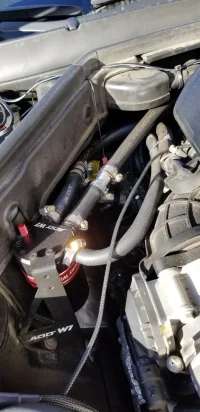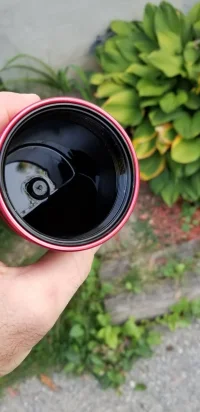Wan El Guapo:
My post is truly an opinion. Facts vs. opinions are for those who care, to decipher. In the oil catch can topic, as I see it, here are some facts;
* catch cans were NOT engineered into the Kia Stinger design.
True. Why? Good question. GDI engines in particular are susceptible to build-up in the intake systems (particularly around intake valves) because they inject the fuel directly into the cylinder rather than into the intake airstream, and there's no flow of fuel over the valve stems/seats/etc to wash them clean and cool them (hotter components lead to more oil burn-on) as there is in a port-injected engine.
I suspect the reason (opinion) they're not in the design is that they add cost and complexity to the design for an issue that Kia don't consider to be something likely to bite them within the warranty period (or that the cost of engineering and including into the design would cost more than remediating the issues caused by not having one). It's very often all about compromise.
* Oil catch cans DO catch oil.
Well designed ones do, yes, and how much they catch depends on how well they're designed. Then you have the difference between a catch-can (that captures the oil and requires draining) and an AOS that generally captures the oil but delivers it back to the sump.
* oil catch cans will cost the consumer additional money.
In what way exactly? Yes, they cost money to buy (so there's a sticker price) and potentially to install.
They're not removing any more oil from the sump than is already being removed by blow-by/etc, so adding a catch-can won't increase your oil consumption (and an AOS that returns oil from the sump may actually reduce it). They're potentially saving the consumer money by (potentially) avoiding issues with oil deposits in the intake tract (a known issue for GDI engines without catch-cans/AOSs) - resolving that issue definitely costs money, so a catch-can/AOS can actually save money here.
* oil catch cans are NOT installed by authorized Kia dealerships and WILL void the vehicles mechanical warranty
I cannot agree here. Some dealerships WILL install them. Adding a catch-can (or AOS) can only void warranty for an issue directly impacted by the installation of the catch-can/AOS. Kia cannot refuse a warranty claim where the catch-can or AOS did not contribute to the failure.
The notion that having a fully functional item added to a car that causes no direct issues can completely void the entire mechanical warranty on a vehicle is ridiculous.
* oil catch cans MAY somehow lesson or alleviate a problem that has been perceived yet not proven (at least with this engine). I’m sure there are more as well.
The fact that catch-cans are catching oil at all is proof that they're doing something - there's no place for oil in the inlet system of an engine (GDI or otherwise) - if it did, they'd inject it there on purpose. Oil ends up in the intake system of engines as a byproduct of compromises in engine design and engineering - it's possible to stop it (or reduce it), but the cost of doing so (in terms of efficiency, engineering efforts, etc) is substantial.
It's well know that oil in the intake system causes build-ups of burned residue, it's well established that the issue is worse in direct-injected engines, and the cost of remediation of such issues is significant (often requiring the pulling down of the entire intake side of the engine and cleaning/replacing of parts - assuming it doesn't cause other issues such as component failure due to a number of likely scenarios. It's also well established that the oil that doesn't build up inside the inlet system can only go one place - the combustion chamber, and it's known to have a negative impact on the efficiency of the combustion process (it effectively lowers the octane level of the combustion charge, meaning hotter and less well controlled combustion, requiring pulling back of timing resulting in less power being produced).
Fact is, WE can prove all day long this chip or that exhaust will make your Stinger faster/louder and so much more. Even more than it was designed to be. WE can back these facts with quarter mile run sheets and dyno results. This can and will continue...
Yes - and these things generally adjust the level of compromise made in the design of the car (almost all engineering is about compromise).
My post is because I’m finally settling in with why I bought this car to begin with. It’s design is excellent. It’s look is flattering. And it’s likelihood of safe/reliable performance is almost assured by Kia’s exceptional warranty (vs. other manufactures). The kid in me starts falling by way of this re-engineering and race/performance stuff.... and sometimes, the maturity sets in and I start thinking things through. I’m jUst trying to remind the folks out there, there’s much more to this than on the surface. It’s OK to like the Stinger for what it is - an awesome GT car.
On the downside, the parent/grandparent in me fears the day I read a headline where some Stinger owner racing on the streets hurts themselves or even worse, someone innocent. I’m just a bit tired of seeing this forum turning more and more into a “I Beat This” or “I raced This” spot. Maybe I’m too old.... too mature... or have finally stopped in the “I’ve got a bigger ____ game. Once again - purely my opinion.
To all my fellow Stinger owners; drive proud - drive safe.... and drive with a smile. Cheers, db
Little argument from me on this last stuff. It's clearly a good car - it "has good bones". The Stinger does an exceptional job as it comes from the factory, and for the vast majority of owners, probably requires no adjustment.
But it isn't perfect, and for some, the compromises that Kia decided to make don't suit their requirements, and so they choose to adjust. More power to them.
I'm not big on the "I chopped this" threads, or the "Who has the most HP/kW/bigger e-peen" threads - but that's fine, I simply avoid becoming a competitor in them. For others who love them, great - as long as they're being safe and sensible, it's not my place to tell them how to live their lives or what's important to them to be happy.








